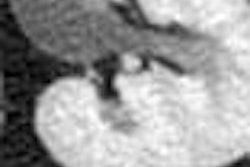PHILADELPHIA - FDG-PET can play an important role in restaging patients with suspected lung cancer recurrence, according to researchers from the State University of New York in Buffalo.
"FDG-PET imaging is useful in the management of patients with suspected recurrence of lung cancer, by more accurately depicting the extent of disease recurrence and clarifying radiographic equivocal findings," said Dr. Mohei Abouzied. He presented the SUNY team's research Monday at the Society of Nuclear Medicine meeting.
While FDG-PET has been utilized effectively for more than a decade to stage patients with lung cancer, in this study the researchers sought to assess its usefulness in restaging patients with suspected lung cancer recurrence. The group also wanted to determine the prognostic value of FDG-PET and its correlation with survival rates for recurrent lung cancer.
The patient population included 58 patients (38 female, 20 male, mean age 66) with known or suspected lung cancer recurrence. They underwent FDG-PET scans between March 2001 and January 2003 as part of their restaging workup. There were 17 postsurgical resections and 41 post-chemoradiotherapy and/or surgery patients.
FDG-PET (CPET Plus, Philips Medical Systems, Andover, MA) studies were used to assess the extent of recurrent disease in case with positive CT findings in 23 cases, or to clarify equivocal CT findings in 35 cases. All patients had CT of the chest, abdomen, and pelvis prior to the study.
The scans were reviewed by two nuclear medicine physicians and assigned findings of negative, positive with local recurrence, positive with local and distance recurrence. The results were then correlated with conventional diagnostic scan findings (pre- and post-PET), histopathology, and clinical follow-up.
In the first group of patients, FDG-PET depicted new metastasis sites in 11 of 23 patients; findings were concordant with CT results in the remaining cases. For the patients receiving FDG-PET to clarify equivocal CT findings, FDG-PET findings were indicative of malignancy in 20 of 35 patients, and new metastatic sites were depicted in 11 of 35 patients, Abouzied said.
Of the 58 patients, 15 were upgraded following the depiction of distant metastases. Malignancy was properly excluded in 16 of the 58 patients, and overall there were true-positive findings in 39 of 58 patients. There were no false-positive results, resulting in specificity of 100% and a positive predictive value of 100%.
Of the 19 negative FDG-PET findings, there were three false-negatives, for an overall sensitivity of 93% and a 84% negative predictive value. Two of those patients had lesions smaller than 1 cm, while one had a malignant pleural effusion, Abouzied said.
From the results of FDG-PET imaging, patient management was changed from curative to palliative in 18 patients. In eight cases, a negative FDG-PET finding precluded active management, he said. One patient with a positive FDG-PET finding received curative resection. As a result, patient management was changed in 46% of patients, Abouzied said.
By Erik L. RidleyAuntMinnie.com staff writer
June 22, 2004
Related Reading
FDG-PET improves staging of small-cell lung cancer, June 21, 2004
PET Medicare reimbursement -- narrow but widening, June 17, 2004
PET shows power in both small and non-small cell lung cancer staging, survival, June 6, 2004
Use of fused PET/CT images may improve radiation targeting for lung cancer, May 25, 2004
Separating inflammation from malignancy on thoracic FDG-PET, April 9, 2004
Copyright © 2004 AuntMinnie.com





















